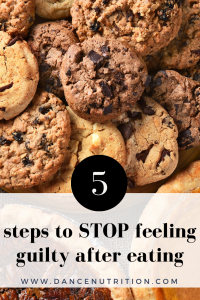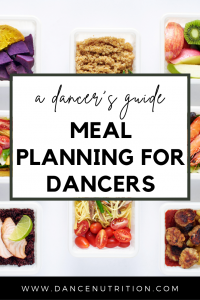Facts
Absolutely. Because of the unfortunate body ideals of our industry, dancers are known to be three times more likely to struggle with an eating disorder. Dancers are vulnerable to overwhelming food rules, which increase a dancer’s susceptibility to feelings of food guilt and compensatory eating (a binge-and-restrict cycle). This limits both their physical performance and artistic potential.
Intuitive eating is a lifestyle approach that was created by two registered dietitians, Evelyn Tribole and Elyse Resch, in 1995. There are 10 science-based principles of intuitive eating, including:
- Reject the diet mentality
- Honor Your Hunger
- Make Peace with Food
- Challenge the Food Police
- Discover the Satisfaction Factor
- Feel Your Fullness
- Cope with Your Emotions with Kindness
- Respect Your Body
- Movement—Feel the Difference
- Honor Your Health—Gentle Nutrition
Instead of making food choices based on calorie goals or what’s “good” or “healthy,” you discover what foods satisfy both your body and your soul. Eventually, you build trust with yourself around “tempting” foods that either you or society has previously deemed off-limits. To learn more about how dancers can integrate Intuitive Eating alongside Performance-based eating, read this article.
Nutrition workshops can be provided to dancers in group settings, usually at studios or within dance companies. Nurturing The Healthy Dancer® is a customizable nutrition workshop designed by Registered Dietitian Nutritionist and dancer Rachel Fine of To The Pointe Nutrition. A snapshot of topics covered in this dance nutrition workshop include:
- The risks of disordered eating among dancers.
- The importance of balance among the macronutrients.
- The key elements of building sustainable habits around meals and snacks.
- Boosting body image and body confidence.
- The role of nutrition in injury prevention.
- The role of nutrition in injury recovery.
- Meal planning and the role of pre-performance nutrition principles.
Since 2013, Rachel has brought her expertise to studios and companies worldwide. Dance educators should consider Nurturing The Healthy Dancer® as a sound option to build their dancers’ knowledge of food and nutrition. Click here to learn more about the benefits of nutrition workshops for dancers and how to determine the right time for a workshop for your dancers.
Incorporate a fuel mix, which includes a source of protein, carbohydrates, and fat at each meal and snack throughout your day. Dancer diet culture often tells us to omit various food groups or to prioritize one macronutrient over the other. However. each macronutrient plays an essential role in maintaining a dancer’s health and performance. Learn more about the importance of nutrition for dancers here.
Dancers often feel guilty after eating foods not deemed “perfect,” “clean,” or “healthy.” Food guilt is a red flag when identifying whether or not a dancer’s relationship with food needs to shift. Dancers can learn 5 tips to help navigate food guilt:
- Identify and Validate Your Feelings of Guilt
- Break Your Food Rules
- Practice Mindful Eating
- Rely On Food and Body Affirmations
- Be Curious, Not Judgmental
While food guilt is a common experience among dancers, it’s also one that can be improved upon. Utilize these key steps for reducing your food guilt and for more support, check out these two helpful articles:
- Nutrition for Dancers- food guilt and dancers
- Pointe Magazine- Cultivating A Healthy Relationship with Food

Calories are essential to a dancer’s active lifestyle. Calories provide the energy needed to not only perform but also to sustain basic metabolic functioning. Eating too few calories risks injury and nutrient deficiencies. Read more about a dancer’s calorie needs here and a dancer’s nutritional needs here.
Protein plays a key role in muscle building and should be part of a dancer’s meal plan. Dancers should pair sources of protein with sources of carbohydrates and fats to optimize energy and rebuild muscles. Read more about a dancer’s nutritional needs here.
Hydration needs are dependent on the individual. It’s recommended that you consult with a Registered Dietitian Nutritionist to determine your needs. Generally, dancers can aim for at least 3 liters of water daily. Daily fluid needs may be higher if dancing for longer than 60 minutes and/or in hot and humid environments. Add a salty snack (like pretzels) and a simple carbohydrate (like fruit) to replenish electrolytes and muscle glycogen. If you’re a dancer looking to learn more about your hydration needs, click here.
Yes, dancers can eat dessert and if the desire exists, dancers can even eat dessert every day! Dancers should strive for a lifestyle where all foods, even those more indulgent options, can fit into a balanced meal plan. Avoiding any one type of food (such sweets/desserts) or food group (such as bread) results in a restrictive and unsustainable lifestyle. Opt out of food rules and enjoy food as an experience, whether that experience is a balanced salad or a brownie sundae! To learn more about dancers eating dessert, click here and to learn more about sugar in a dancer’s diet, read this.
Dancers should create balanced snacks that incorporate a source of carbohydrates, protein, and fat. Pair a serving of nuts with fruit or top yogurt (or dairy alternative) with chopped nuts, dried fruit, and ground flax. The Dance Nutritionist® offers free resources to help dancers build balanced meals and snacks. Click here to learn more about healthy snacks for dancers.
A dancer’s diet should include a balance of the three macronutrients. Carbohydrates are a dancer’s primary fuel source. Complex carbohydrates from foods like whole grains, starchy vegetables, beans, and legumes provide dancers with sustainable energy. Protein helps to rebuild active muscles and unsaturated “healthy” fats (from sources like nuts, seeds, avocados, and olive oil) provide anti-inflammatory benefits to repair working muscles.
Dance nutrition applies the fundamentals of Sports Nutrition, such as those set forth by the American College of Sports Medicine. Nutritious meals fuel a dancer’s performance and reduce the risk of injury.
Dancers can work with a Registered Dietitian Nutritionist to learn more about utilizing a holistic approach to food. Holistic nutrition for dancers utilizes a non-prescriptive but guided, approach to understanding how to fuel the body in ways that support physical, mental, and emotional well-being. Learn more about holistic nutrition here.
Carbohydrates are a dancer’s best source of energy. Complex carbs are found in plant-based foods like whole grains, fruits, veggies, legumes, nuts, and seeds. Whole grains are particularly high in energizing nutrients like iron, zinc, and vitamin B12. Read more about how dancer’s should incorporate carbs in their diet, click here.
Fat is an essential nutrient for the body. Fat promotes satisfaction at meals and keeps us feeling full for longer. Unsaturated fats are particularly beneficial to a dancer’s body, which undergoes a great deal of wear-and-tear from high levels of physical activity. Read more about a dancer’s nutritional needs here.
Dancers are vulnerable to disordered eating habits given the art form’s emphasis on body physique. Licensed professionals, such as Registered Dietitian Nutritionists, work with dancers to craft meal plans that optimize performance potential.
Dancers can benefit from meal planning. Meal planning involves setting time aside to plan your day’s or week’s meals and snacks. Since dancers are at risk for disordered eating habits, those with a history of restrictive eating may benefit from meal planning as a way to provide external structure when interoceptive awareness (AKA innate hunger/fullness cues) is diminished.
Dancers can utilize my 3 tips for learning how to meal plan in a way that is easy and sustainable. Click here to read more and find helpful meal planning tips designed for dancers.



